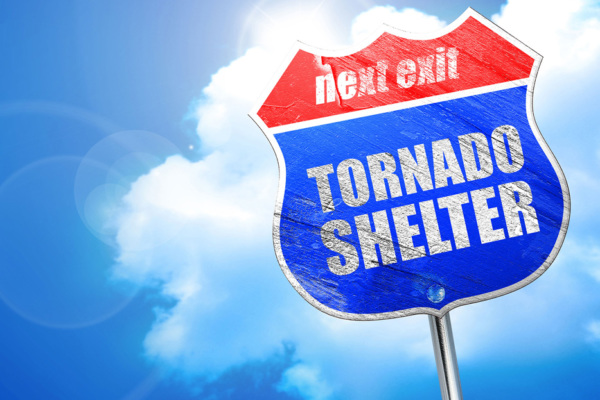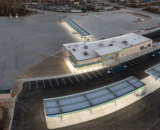Natural disasters, such as floods, hurricanes or tornadoes, can interrupt business operations and leave truckstop and travel plaza operators faced with difficult decisions. Business owners have to figure out how to keep fuel tanks full and their operations running as they work to serve their customers or even first responders. Those within the industry told Stop Watch they have adopted several best practices that help them keep their customers and employees safe when disaster strikes.
“Mother Nature can be a beast. When those warnings come, we try to heed them,” said Randy Haines, service center director for Boss Truck Shops Inc., which are a part of Bosselman’s Truckstops.
Nate Oland, senior national account executive for Federated Insurance, said a disaster plan should be an essential part of any strong business continuity plan. “Choosing to not take the time to prepare is the biggest mistake a business owner can make,” Oland said. “Many victims think a disaster will never strike their business, but that attitude leaves dealers vulnerable and in a potentially devastating position.”
Preparing for a Storm
Michael Sibley, president of LaPlace Travel Center, said the location experiences the threat of a hurricane a couple of times a year. “When we learn one is on its way, I send my checklist to my manager. Then we make a point to talk more and more as the storm moves closer,” Sibley said. (Download a sample hurricane checklist here.)
Since LaPlace Travel Center is open 24/7, it is unusual that employees have to lock the doors and set the alarm, Sibley said. Usually, when the location tests things, the locks won’t work, they can’t find the keys or don’t remember the process to set the alarm. “These are the things to check before they are needed,” he said.
Bosselman's regularly conducts drills for tornadoes, and closely tracks potential storms, which Haines said has gotten easier with technology. “We pretty much know when storms are coming, and we can prepare for them,” he said.
Federated Insurance has partnered with the Insurance Institute for Business and Home Safety, which has developed a simple plan called Open for Business EZ. “This plan guides businesses and homeowners through the process of planning for a disaster,” Oland said. “This is a great tool for anyone either starting or enhancing their disaster preparedness planning.”
“Don’t wait until it’s too late,” Oland said, adding that business owners should customize any plan for their specific operations. “Size-up your vulnerabilities. Make a plan. Include employees, vendors, customers and community. Do a table-top exercise to help ensure the plan can work.”
As a best practice, travel plazas should keep documentation of equipment, inventory, parts and supplies that are used in day-to-day operations. “It is best to have this written out and saved electronically off-site or in cloud-based storage,” Oland said. “In addition, many dealers will also take a video of their entire property to help reproduce memory of the tools, equipment and other inventory they may have forgotten about. This, too, should be stored off-site or in a cloud-based system.”
Responding to Road Closures
Recently, flooding led to road closures and new traffic patterns at a Bosselman’s location in Nebraska, Haines said. “With the road closures, obviously traffic doesn’t come through a location or certain lane anymore, so it is pretty detrimental on the sales,” he said, adding that the flooding disrupted roads for a month. “You just have to wait it out and try to do as best you can with what you have.”
Keeping fuel flowing in a natural disaster is critical, particularly as people look to flee a storm or as first responders move in.
The Midwest can be hit with blizzards in the winter, and Haines said storms in Wyoming can often lead to disruptions in Nebraska. Interstate 80 through Nebraska will close because of exit closures throughout Wyoming. “After one-exit fills up, they’ll block that exit and then the next. It is a cyclical thing all the way across Nebraska. It will be 65 degrees here, but people can’t get through.”
The Bosselman’s location in Grand Island, Nebraska, will get 600 trucks parked at it as drivers wait out Wyoming’s weather. “It kills fuel sales because nobody wants to move from their premium parking place,” Haines said, adding that road closures do boost restaurant sales. “They’ll eat you out of house and home.”
LaPlace Travel Center has some low-level access flooding that occurs, making the store inaccessible when the streets start to flood. Sibley said the location experienced roadblocks after Katrina when the government shut all the roads down.
“It is difficult getting past road-blocks, but they have all improved their plans,” Sibley said. “Our Parish has an emergency operation center coordinator that maintains a list of key employees that should be allowed through.”
The coordinator provides a letter that crucial employees can carry with them when they evacuate to use if they are trying to get back to the store, Sibley explained. “It would be most helpful for other store owners to reach out to their local governments to find out what their system is,” he said. [See a sample letter here.]
Keeping Tanks Full
Keeping fuel flowing in a natural disaster is critical, particularly as people look to flee a storm or as first responders move in.
Don Quinn, vice president of NATSO Services, said some gas supply contracts prohibit dropping unbranded gas into a tank, but he said he experienced shortages during his career. “The branded supplier was out of the product at both the primary supply terminal and the back-up terminal due to the pipeline that supplied the region being flooded,” he said, adding that it can be helpful to incorporate language into the agreement allowing for exceptions during certain circumstances.
Sibley’s supplier has electronic access to his tank levels, so he knows when the location needs fuel. “He does a great job of taking care of us, plus it is in his contract to never let me run out,” he said.
Sibley has only been unable to get fuel from his supplier once, which happened during Katrina. “When that happened, I called a huge independent supplier, and he brought me a few loads until my supplier was able to get to me. Having those two guys’ cell numbers, and their first assistants’ as well, is a good thing to know is current,” Sibley said.
Haines said most often retailers can pull fuel from another terminal, but it can increase costs.
Maintaining Communciation
Communication is one of the most critical elements when preparing for or responding to a disaster, Quinn said. “You will need to communicate with employees, vendors, customers and local authorities, such as law enforcement and emergency management personnel,” he said.
Sibley said his router has backup cellular service for if or when the cable connection goes down.
If phone lines go down at Bosselman’s locations, the company directs calls to its 24-hour call center, and individual locations can follow up via cell phones.
Quinn said NATSO can help its members communicate with government agencies as operators work to keep fuel and the public moving. “Don’t underestimate the resources NATSO can assist with, such as communications with the Federal Emergency Management Association, the Department of Transportation and others to assist in issues such as hours- of-service waivers for transport drivers or allowing intrastate trucks to go interstate,” Quinn said.
Getting Employees to Work
For operators, one of the biggest weather-related challenges is keeping employees working. “My experience is that if it is very difficult for employees to travel to and from work, this will correlate to not much fuel being sold,” Quinn said. “However, this can turn your location into the temporary emergency shelter providing food and shelter for all travelers.”
If that happens, it can result in incredibly long hours for everyone. “You will also be amazed at how employees and customers alike step up to help their fellow man in times of difficulty,” Quinn said.
Sibley said employees can be hesitant to travel into work if bad weather is on the horizon. “Since we have been hit a few times, now our employees are really ‘gun-shy,’” he said, adding that overzealous media reports start scaring everyone, even when the storm is a week away. “Our employees freak out and start calling off for their shifts.”
Sibley watches the storm’s path, filters out the media noise, and tries to keep employees focusing on reality and working. “As it gets closer, we make decisions about if and when we will close,” he said.
LaPlace Travel Center also has an escalating bonus structure for employees who are willing to be there for the last few shifts before the location closes and those who work the first few shifts after a storm.
In the past, managers at Bosselman’s would drive employees to and from work, but Haines said that is changing with millennials. “Millennials don't think like the old school people. We used to drive through snowstorms to get to work and take more risks,” he said. “Now millennials are comfortable saying, ‘I'm staying home.’ The younger generation doesn't like to take those risks.”
Haines said there are usually employees who will volunteer for a double shift, and Bosselman’s will rent nearby lodging for employees. “We are always the first to reserve five rooms for our help,” Haines said. “We get them motel rooms so they have a place to shower and sleep.”
Bosselman’s doesn’t take any chances with its employees’ safety. “The liabilities to force somebody to come to work or strongly suggest they get to work are too great,” Haines said.
Disasters can also affect company employees even if the location isn't harmed. “This company is just unbelievable as far as doing fundraisers or helping those people who are affected,” Haines said. “We had a sales associate in Fort Meyers, Florida, lose everything she owns. We did a fundraiser to get her in a new house.”
“After Katrina, we invested a lot for a huge generator that can run the entire building. It has been useful for a couple of hurricanes since then as well as numerous small storms or random non-storm related power issues. This is a must have.”
Keeping the Lights On
Sibley has invested in generators to keep the location running in the event of a power outage. “After Katrina, we invested a lot for a huge generator that can run the entire building. It has been useful for a couple of hurricanes since then as well as numerous small storms or random non-storm related power issues. This is a must have,” he said, adding that it is also a bonus for employees without power who like to come to work in the air conditioning.
For many locations, it doesn’t make economic sense to install generators. “However, it does make sense to consider installing electrical lugs for quick connection of a generator in the event you need one,” Quinn said. “This is a fairly minimal cost when building and designing a new facility.”
Bosselman’s doesn’t have generators, but Haines said the company can use generators on its service trucks. “We’ll use the air compressors and all of the power off of the service trucks when we lose power.”
Planning Coverage
Oland suggested that truckstop or travel plaza owners, along with their insurance professionals, examine their risk management and insurance program at least annually. “This includes reviewing limits, coverages and available risk management tools,” he said.
Oland said it can take a business eight to 12 months to rebuild after a disaster and business income coverage is available. However, some policies provide only limited coverage for payroll. “A dealer should discuss this exposure and available coverage with their marketing representative,” Oland said.
Managing Losses
If a loss occurs, Oland said operators should close out the books on the date of the loss and maintain a separate, accurate record of any sales or operating expenses that continue after the loss. “The insurance adjuster will need to verify these expenses as part of the claim process,” he said, adding that operators should start a physical inventory as soon as possible.
Operators should also maintain accurate records for extra expenses incurred to expedite the resumption of operations, Oland said. He also advised them to create a written record of any communications received regarding orders to evacuate, including who ordered the evacuation, the date and the time.
Quinn said another best practice would be to keep records of conversations, pictures of damages and lists of lost items for insurance coverages as disasters are continually evolving situations.
Subscribe to Updates
NATSO provides a breadth of information created to strengthen travel plazas’ ability to meet the needs of the travelling public in an age of disruption. This includes knowledge filled blog posts, articles and publications. If you would like to receive a digest of blog post and articles directly in your inbox, please provide your name, email and the frequency of the updates you want to receive the email digest.


